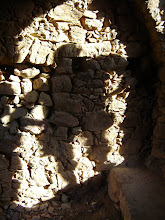When Google Street View comes to a sudden halt at De Locht, on the Netherlands’ south-eastern rim, you might be forgiven for thinking that this is where the world ends, which, in the minds of many people, it probably does. Centrality and peripherality are concepts that pervade the national psyche, the idea being that the metropolitan area is the vibrant heartbeat of the nation and the provinces the frost-bitten extremities.
This view is perhaps best encapsulated in Saul Steinberg’s depiction of the world as seen from New York’s 9th Avenue, which first appeared on the front cover of the New Yorker magazine in 1976. The image shows Manhattan’s 9th Avenue, 10th Avenue, and the Hudson River, while the top half depicts the rest of the world. The rest of the United States is drawn as a square, with a thin brown strip along the Hudson representing New Jersey, the names of five cities (Los Angeles, Washington D.C., Las Vegas, Kansas City, and Chicago) and three states (Texas, Utah and Nebraska) are scattered among a few rocks for the U.S. beyond New Jersey. Whilst taken to an extreme in this example, this metropolitan self-image (and self-importance) persists, not just in the States, but in countries like the Netherlands too.
Not long ago, I was at a translator’s conference near Amsterdam, 250 kilometres from where I live on the Dutch-German border. It’s always interesting to observe how people react when - in my quaint Limburg accent - I tell them about my domicile in the nethermost region of the Netherlands. Some are vaguely aware that Heerlen is close to Maastricht, the southernmost outpost of the realm, whilst others just offer detached, condescending looks, as if to point out the inconsequentiality of my marginal existence. This swaggering self-assurance of the world’s metropolists is a readily identifiable trait, not only amongst the Ranstedelingen of Holland, but amongst Londoners, Berliners, Parisians and Madrileños too. In fact, in itself this characteristic has a curious, inverted kind of quaintness to it. Coming from an island, I can perhaps more readily accept it. After all, the remote corners of the British mainland are extremities by definition: once you get to Land’s End or John o’Groats, you simply drop off the cliff edge.
But De Locht on the other hand, which lies 4 kilometres south of my home, is a different kettle of fish. Here, the cliff edge may be an imaginary one, but in the minds of those who have been conditioned to think in terms of centrality and peripherality is perhaps no less real. At the edge of my cliff however, is the historic city of Aachen - just a cycle ride away - where the rulers of the Holy Roman Empire once held sway. The city of Aachen may have lost its imperial lustre over the centuries, but its current population is still comparable in size to that of Utrecht, the Netherlands’ fourth largest city. Its university, the RWTH – with more students than any similar such institution in the Netherlands - has been independently rated as Germany’s top centre of learning and attracts students from all over the world. In the other direction, beyond Maastricht, is the French-speaking cultural centre of Belgium, Liège, at the heart of a major industrial conurbation whose population dwarfs that of The Hague. (Dutch holidaymakers will be familiar with Liège as the first major settlement they come to as they trundle south with their caravans in tow.) It should also be remembered that the region between Liège and Aachen was the first to be developed industrially on the European mainland. Cologne, Düsseldorf and Brussels too, are within easy striking distance, so from my perspective it’s strange to think that some in the Randstad perceive Limburg as being beyond the pale.
‘Population potential’ is a tool that geographers use to quantify the centrality and peripherality of any given geographical location. It measures the proximity of a point in space to other centres of population. If the Netherlands were to be seen in isolation from the rest of Europe, then Limburg, and Heerlen in particular, would - in relation to the high-density regions of the Randstad - be seen as an outlier, scoring low on centrality and high on peripherality. But the world does not end at De Locht, as Google Street View would have us believe. In fact, if we look at population potential at a European level, the picture changes considerably. The isopleths shown in the title map clearly show that the population potential of Limburg is on a par with that of most of the Randstad, so the notion of it being ‘remote’ doesn’t really wash.
Centres of power - more or less synonymous with metropolitan areas - will always be at the forefront of political, economic and cultural development. If you're running a nation state, it's the most efficient way - geographically speaking - to manage it. And of course, the notion of centrality, within the national context, is reinforced by a centralised media on a day-to-day basis. Nevertheless, if not held in check, it brings about an unhealthy level of mono-culturalism and one-dimensional mentality which obscures the world beyond.
If you ask me, I’m really quite happy living a ‘marginal’ existence, being able take my pick of three cultures instead of just one. And if that weren't good enough – to make all Randstedelingen green with envy – I enjoy petrol prices (across the border) which are 10 cents cheaper than their own.










